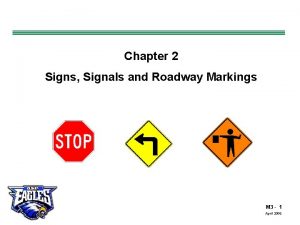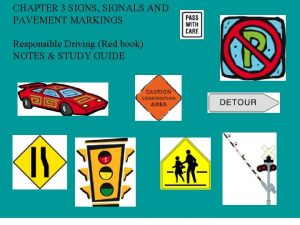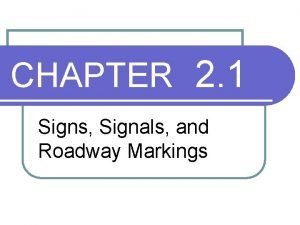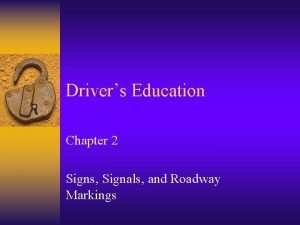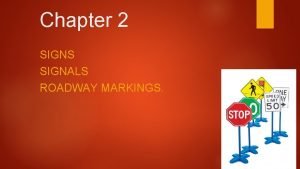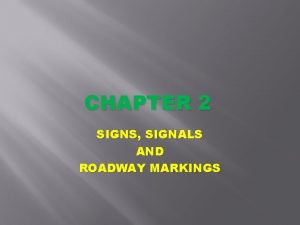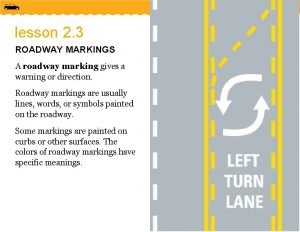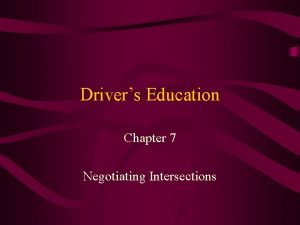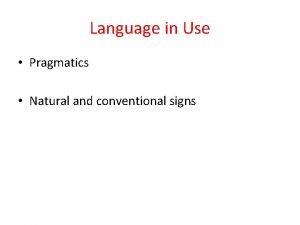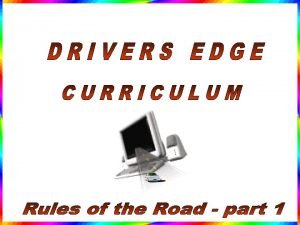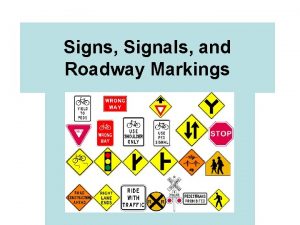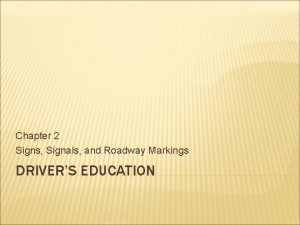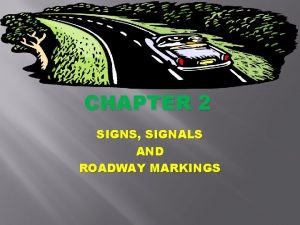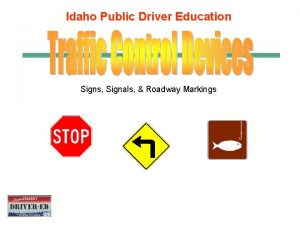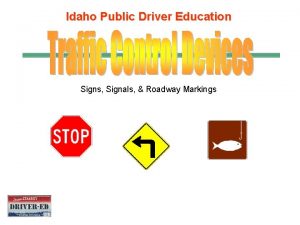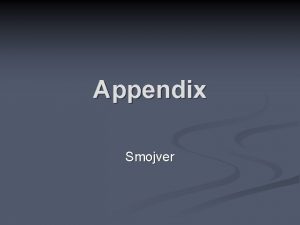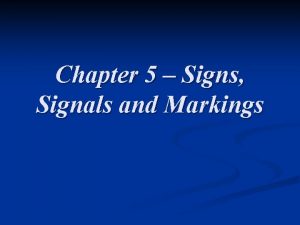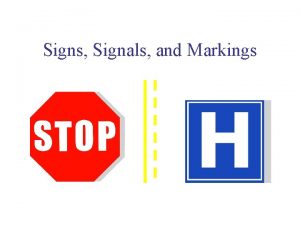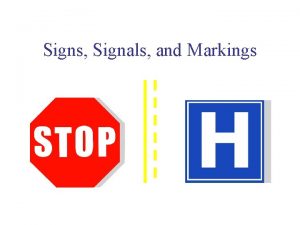Chapter 2 Signs Signals and Roadway Markings 2
















- Slides: 16

Chapter 2: Signs, Signals and Roadway Markings

2. 1: Traffic Signs Every sign’s shape and color have special meaning Regulatory Signs: Signs that set limits, or give commands. Example: stop sign, Yield, One Way, Do Not Enter Colors: Red: Stop, Yield, or Prohibited Orange: Construction Yellow: Warning Black: Regulatory Blue: Motorist Service Green: Guide

2. 1: Traffic Signs Yield Sign: Found where roadways cross or merge. Slow down, check traffic in front and behind you May not need to stop completely at yield sign. Speed Limit: Show MAXIMUM speed allowed in designated areas. Minimums are set on some roadways ▪ Highways Advisory speed limits are set for special condition ▪ Sharpe Curves

2. 1: Traffic Signs Warning Signs: Alert you to hazards or changes in the condition of the road ahead. Most are Diamond in Shape. Also include railroad crossing, and pedestrian/school zone.

2. 1: Traffic Signs Guide Signs: Mark routes intersections, service areas, and others points of interest Typically, black, blue, or green. Route signs: Local, state, and interstate routes. State and county routes may vary state to state Other Guide signs: Mileage and destination signs

2. 1: Traffic Signs ODD/EVEN Odd numbers depict north and south routes. Even Numbers depict east and west routes. Three Figured numbers BEGIN with ODD = goes INTO a city BEGIN with EVEN = Go AROUND a City.

2. 1: Traffic Signs U. S Route Marker 2 Digit Interstate Route Marker North and South State Route Marker 3 Digit Interstate Route Marker Around City County Route Marker Destination Sign

2. 2: Traffic Signals Traffic Signal: Lights, arrows, flashing signals, and pedestrian signals are used to help traffic flow smoothly. Traffic Lights; RED : MUST Come to a full stop YELLOW: “Caution” Make every effort to stop safely GREEN: Drivers may proceed when intersection is clear.

2. 2: Traffic Signals At most intersections drivers are allowed to make a Right-Turn-on-Red; turning right after stopping when the signal is red. Left-Turn-on-Red may occur when turning from a one way street onto another one way street.

2. 2: Traffic Signals Flashing Signals: Alert drivers to dangerous conditions or tell drivers to stop. Arrows: regulate the movement of traffic on a particular path through an intersection. Red Arrows: STOP driver may not go this direction Yellow Arrow: Arrow is about to turn red Green: May proceed only in the direction the arrow is pointing when intersection is safe.

2. 2: Traffic Signals Pedestrian Signals: ensure the safety of people who are walking Pedestrians should always obey “Walk” and “Don’t Walk” Signals Walk Signal Don’t Walk Signal Drivers and pedestrians should always follow the instructions of a traffic patrol officer. Under any circumstance.

2. 3: Roadway Markings Roadway Marking: are usually lines, words, or symbols painted on the roadway. Give warning or direction Yellow Lane markings: separate traffic in opposite directions on two way roads. Single Line: single broken yellow line indicates that you may pass but only when no traffic is coming from opposite direction.

2. 3: Roadway Markings Double Yellow Lines: divide traffic and prohibit passing. Solid and broken Line together: indicates passing ONLY on the side which has the broken line. White Lane Markings: separate lanes moving in the same direction. Broken white line indicates passing is allowed Solid line prohibits passing.

2. 3 Roadway Markings Other Roadway Markings. Stop line: where the driver should come to a complete stop before entering an intersection Cross Walk: Where pedestrians will cross road, be aware for children and other pedestrians. ▪ Solid white lines with diagonal crossings. Shared left turn lane: assist drivers turning left into businesses in the middle of a block. Both sides of road may use this lane. HOV Lane: carpool lane. 2+ or 3+ passengers only! ▪ Designated with a white diamond.

2. 3 Roadway Markings Shared left Turn Stop Line Speed Bumps Handicap Parking HOV Lane Cross Walk Rumble Strips

2. 3: Roadway Markings Rumble Strips: Short sections or groved or corrugated roadway Cause car to vibrate and make a loud noise Indicate to reduce speed, or danger of going off the road. Speed Bumps: Put in areas to force drivers to reduce speed Go over speed bumps no faster than 5 mhp
 Signs signals and roadway markings
Signs signals and roadway markings Regulatory signs color
Regulatory signs color Which is the shape of a no passing zone sign?
Which is the shape of a no passing zone sign? Chapter 3 signs signals and pavement markings
Chapter 3 signs signals and pavement markings Signs signals and roadway markings
Signs signals and roadway markings A short section of corrugated roadway that warns of hazards
A short section of corrugated roadway that warns of hazards Sign shapes meaning
Sign shapes meaning What are six types of special roadway markings?
What are six types of special roadway markings? What are the six types of special roadway markings
What are the six types of special roadway markings Red raised roadway marker
Red raised roadway marker Communicative signals and informative signals
Communicative signals and informative signals Communicative signals and informative signals
Communicative signals and informative signals Communicative and informative signals
Communicative and informative signals Controlled railroad crossings usually have
Controlled railroad crossings usually have Difference between natural and conventional signs
Difference between natural and conventional signs The color of a recreation area sign is ______________.
The color of a recreation area sign is ______________. The diamond shape is used exclusively for _____ signs.
The diamond shape is used exclusively for _____ signs.
